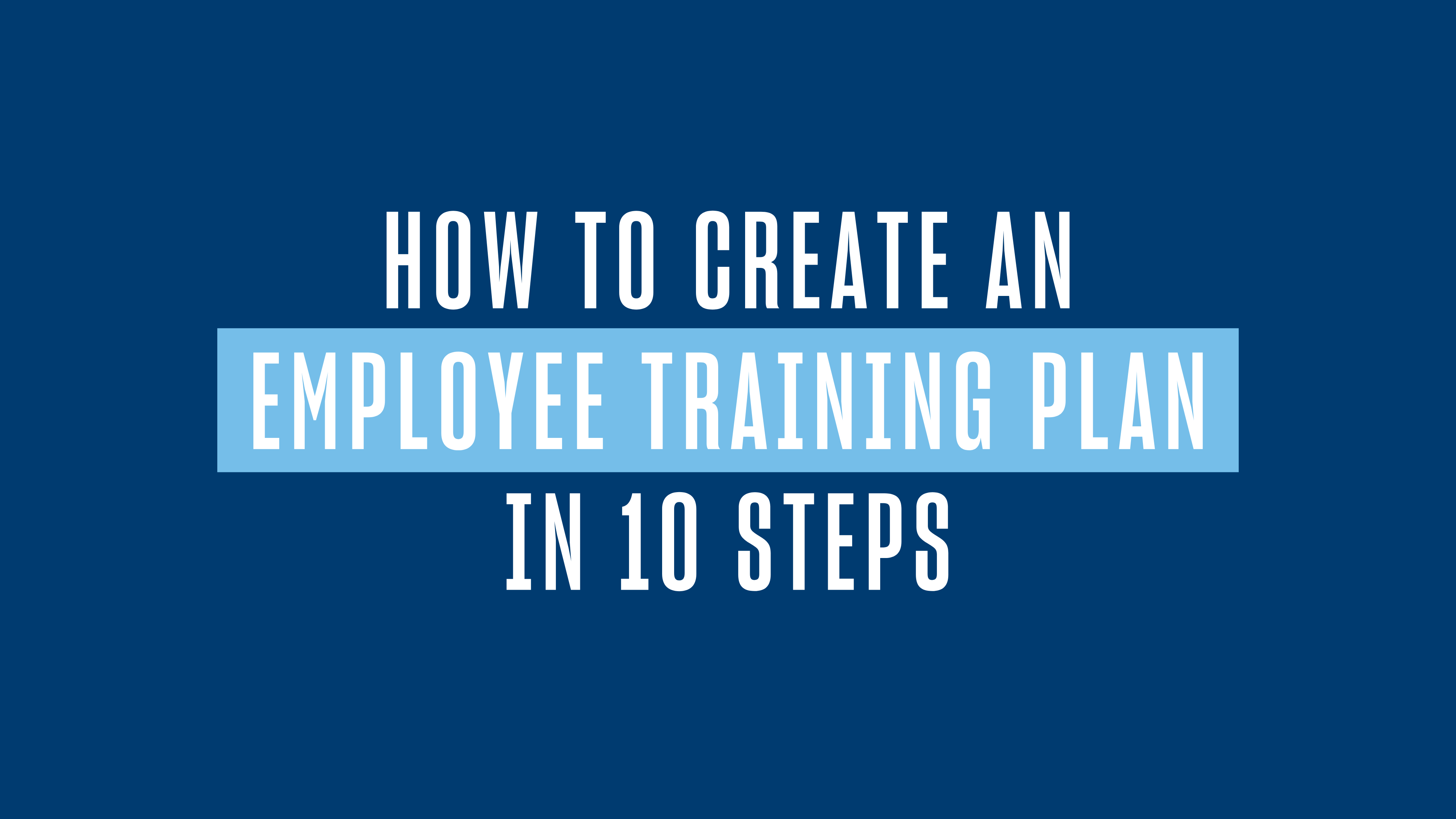An employee training program has the ability to be an extremely successful and useful resource — and continuing education is something that the workforce seems to value. In fact, according to TalentLyft, “90% of employees would stay with a company longer if there was an investment in learning.” 360Learning explains that “employee training programs and, by extension, learning and developing departments are powerful tools in hiring, retaining, and retraining employees.”
Employee training programs can focus on everything from onboarding new employees to addressing general or specialized skills, topics, etc. for current employees. Whether you’re looking to create one (or multiple) programs or just want to refresh your current training content, read on to discover steps to creating a successful training course or program — plus examples of training programs from top companies and tips for choosing the right instruction model.
How to Create a Successful Training Course or Program: 10 Steps
1. Assess your needs and develop goals and success metrics.
The first step to any successful training program is to establish your goals as a business or department and figure out what you need to successfully achieve them. It’s also important to establish key performance indicators (KPIs), which Investopedia defines as “a set of quantifiable measurements used to gauge a company’s overall long-term performance. KPIs specifically help determine a company’s strategic, financial, and operational achievements, especially compared to those of other businesses within the same sector.”
Here are some questions to consider:
- Who is the intended audience of your training program?
- What are your short-term and long-term goals?
- What is the timeframe for those goals?
- How will you measure success?
- What does success look like to the employees?
- How will you know if participants have learned what you intended?
2. Determine the type of employee training plan.
In discussing your goals and objectives, you also want to consider the type of training program you want to implement. Here are some ideas, courtesy of Workable:
- Classroom style vs. workshop style
- In-house seminars vs. industry conferences
- Individual vs. group training
- Skills-based training vs. management training
- On-the-job training vs. external resources training
- Professional, safety or quality training
- Online vs. in person
- Self-paced or structured timeline
Other suggestions from Indeed include:
- Group training activities
- Hands-on training
- Instructor-led training
3. Keep adult learning principles in mind.
Adults who are participating in an employee training plan often come to the table with more experience than young students in an academic setting. As eLearning Industry explains, you should keep certain characteristics of adult learners in mind, including:
- Experience will play an important part in any type of learning
- Learning should incorporate real-world applications
- Adult learners are typically ready and willing to learn especially if the content is interesting to them
- Adult learners must be involved in the process, whether that’s developing content or creating evaluation criteria
4. Develop learning objectives/outline.
Remember the outlines you likely had to complete in high school English class to flesh out a writing idea? Well, the same idea applies here. What topics do you want to cover? What’s the most important information? How do you want to begin and end? Figuring out the answers to those questions will help drive the structure of your employee training plan — and ensure you hit all the important points.
5. Finalize your training plan.
After you have an established outline with your learning objectives, now is the time for details. Tip: Keep your learning objectives handy so that you can ensure your plan adequately addresses each one. Tweak your plan as needed. Get feedback from colleagues. Move sections around. Fill in the blanks, add as much detail as possible and make revisions.
6. Design and develop training materials.
A training plan is only as good as its training materials. As Indeed explains: “It’s important to have a design fully prepared before launching into development to ensure nothing goes missing or out of order. Remember to focus on the learning needs of the employees rather than what’s easiest for the trainer, and make sure your content focuses specifically on reaching the learning objectives.”
Training materials can include:
- eLearning
- Training manuals
- PowerPoint or slide presentations
- Job aids
- Workbooks
- Online materials
7. Implement training.
Take care of any logistics ahead of time, like scheduling, testing technology to ensure it works and printing materials. During the actual training, explain the ground rules and convey your expectations before you get started.
8. Evaluate training.
Evaluation and feedback is also an important part of the employee training process. It’s best to solicit this type of feedback from employees as soon as the program is finished so that the information is fresh in everyone’s minds. Consider online surveys or questionnaires for efficiency. Tip: Asking for anonymous feedback may take the pressure off your employees.
9. Measure success.
Indeed recommends analyzing the results over the next month or quarter. Were the objectives met? Were there any tangible changes? “Determine whether the training corresponds with a rise in revenue, a decrease in costs, any changes in productivity and other metrics you choose to monitor.”
10. Reevaluate as necessary.
Just like with any type of program, it’s best to reevaluate within a predetermined amount of time. What’s working? What isn’t? Have the objectives changed? Do you need to measure metrics differently?
15 Common Employee Training Models
Employee training plans allow for flexibility and creativity, and there are a variety of options, depending on the goals of the program, objectives and audience. Here we list some of the most popular training models compiled from eLearning Industry, Indeed and Edgepoint Learning.
- Classroom-based training
- Interactive training
- On-the-job training
- Social learning
- Online training
- Technology-based learning
- Simulators
- Coaching/mentoring
- Instructor-led training
- Role playing
- Films and videos
- Case studies
- Group discussion and activities
- Management/leadership-specific activities
- Lectures
What Makes An Employee Training Program Successful?
The success of an employee training program will largely depend on whether the objectives and goals are met according to the predetermined timelines. But there are many other factors that can make or break a training program. According to BizLibrary they include:
- Program management — Is the program being managed effectively?
- Leadership/stakeholder buy-in — Does the program have support from the top down?
- Relevancy — Does the program contain real-world applications?
- Marketing and communication — Are employees aware of program developments and related opportunities?
- Post-training reinforcement — How can you reinforce the material throughout the year? What kind of refresher courses or materials do you need?
11 Examples of Effective Employee Training Programs
If you’re looking for examples of effective training programs, you have plenty to choose from. Here are some of the top ones, courtesy of TalentLyft:
- New hires at Amazon participate in a month-long training and hourly employees who have been part of the company for more than a year are eligible to participate in the Career Choice program, which provides access to educational benefits. In 2019, Amazon committed to more than $700 million for team member retraining “empowering employees to pursue their professional dreams while allowing the retail giant to close skill gaps.”
- In addition to a comprehensive tuition assistance program, AT&T offers internal employee training and development programs. AT&T University offers “an executive-led training program focusing on subjects like management and leadership.” The company also partnered with Udacity “to create online, self-paced coursework, allowing their workforce access to non-degree programs in subjects like data analytics and mobile development.”
- Etsy is lauded for its “well-rounded approach to employee training and development,” which features “combine proven methodologies, including organizational psychology, adult learning theory, and sociology.” Employees can also use traditional learning opportunities, coaching and online resources and participate in retreats.
Monster also provides a list of top company training programs.
- Seattle Genetics offers tuition reimbursement, onsite training courses and job-related conferences and seminars.
- At SAS, employees can take advantage of professional training and development, career mentoring and a career resource center.
- Bonobos provides classes such as “Managing for Success,” “Fit for Success” and “Know Your Customer.”
- Marriott International, Inc. offers both virtual and in-person training opportunities focusing on skill developing, professional development and more.
- Training programs at Schneider Electric specialize in executive development, leadership, customer education and more. The company also offers a free online education resource, Energy University.
- The Associate Recruiter Incubator Program at CyberCoders “takes educated, highly driven, competitive individuals and teaches them to apply technology to a diverse marketplace.”
- Paychex offers customized new-hire employee programs with a combination of virtual learning and instructor-led training.
Training programs at Randstad US include certifications, new manager skills, leadership development, presentation skills and more.
How to Choose the Right Employee Training Model
As you can see, there are a variety of training models, and some will be better fits than others, depending on your objectives and audience. eLearning Industry recommends asking these questions:
- What’s the purpose of the training program?
- Who is the intended audience?
- Are there any constraints?
It’s also important to consider whether you have the space and dedicated time. Would the audience be better served with an instructor-led classroom-type program or a self-paced, online learning module? Would group activities work better to achieve your goals, or is individual learning more appropriate?
Training Program Design Degree Programs
Businesses and corporations across nearly all sectors, government agencies, nonprofits and organizations of all shapes, sizes and missions are also ramping up the shift to remote and online training modalities. An advanced degree can help anyone seeking to launch or advance an instructional design career in education or business, or to work as a freelance learning design consultant.
You can obtain an advanced degree in a variety of training-related topics, including:
- Master of Science in Learning Design & Technology
- Master of Science in Management
- MBA in Strategic Management
- Master of Education in Global Training and Development
- M.Ed. E-Learning
- MED Instructional Design & Technology
Training Curriculum Creation and Design Resources
- Education Development Center
- Training Management Resources from The Balance Careers
- HR Toolkit: How to Build Your First Employee Training Program from Workable
- The Top 26 Most Used Online Employee Training Tools
- EdTech Books: Instructional Design Models
- CourseArc: 10 Helpful Resources for Online Course Designers
Training Program Creation and Design FAQs
Q: Why is an employee training program beneficial?
A: These types of programs are great tools when it comes to onboarding, developing and retaining employees. They can make employees feel supported and like the company is invested in their future.
Q: What does creating an employee training program entail?
A: Some of the initial steps include establishing your audience and determining overall objectives, goals and success metrics. You will then develop an outline that will serve as the foundation of your training program. Once that is finalized, you can begin designing and developing training materials.
Q: How do I know which program is right for my company/organization?
A: The right program will largely depend on your audience and goals/objectives. If your employees are mostly remote, a virtual training session or individual, self-paced module might make more sense. But if you’re looking to foster creativity and collaboration, a hands-on group activity may be a good option.
Q: What are the benefits of obtaining an advanced degree in learning design and technology?
A: If 2020 has taught us anything, it’s that online learning is here to stay — and the need for effective, professionally designed educational and training materials is more important than ever. Businesses, organizations, colleges and universities are continually looking for ways to deliver high-quality learning experiences, and an advanced degree can give you the experience, education and resources you need to implement best practices and take your career to the next level.
If you are interested in learning more about the University of San Diego’s leading-edge online Learning Design and Technology master’s degree program, please be sure to reach out to the team at USD for answers to all of your questions.





